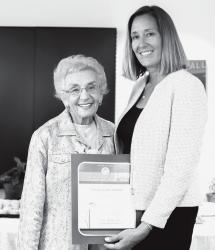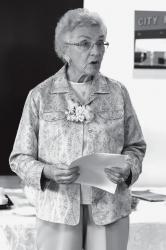WELCOME CELINA—Assemblymember Jacqui Irwin, right, presents Celina Biniaz with the Holocaust Survivor of the Year Award during a celebration in Biniaz's honor at Irwin's Camarillo office June 9. A flick of a pencil. That’s how close Celina Biniaz of Camarillo came to death.
 She was 13 years old when she and her mother were sent to the Nazi concentration camp at Auschwitz, where Biniaz came face to face with Dr. Josef Mengele, the camp physician who became known as the “Angel of Death.”
She was 13 years old when she and her mother were sent to the Nazi concentration camp at Auschwitz, where Biniaz came face to face with Dr. Josef Mengele, the camp physician who became known as the “Angel of Death.”
She became separated from her mother that day and was forced with a group of other women to parade nude before Mengele as he decided who would live and who would go to the gas chamber.
The right side of the line meant life; the left side meant death.
On her first walk through the selection line, Mengele pushed Biniaz to the left side, into a group of older women slated to be killed.
AN AMAZING STORY TO TELL— Celina Biniaz of Camarillo shares the tale of her survival during the Holocaust in which she credits Oskar Schindler, who chose her to work in his factory at the age of 13, during an award presentation. She was the youngest person on Schindler’s list. Then something happened. Mengele ordered all the women to walk through the line again. This time, as he approached Biniaz, she somehow got the courage to look him in the eyes.
 “I don’t know how I got the nerve, but I just looked up at him and said three words in German, ‘Let me go.’ And he let me go,” she said. “He led me to the right, and I ran out. I ran out, nude, with my clothes in my hands. I owe my life to Dr. Mengele’s change of heart.
“I don’t know how I got the nerve, but I just looked up at him and said three words in German, ‘Let me go.’ And he let me go,” she said. “He led me to the right, and I ran out. I ran out, nude, with my clothes in my hands. I owe my life to Dr. Mengele’s change of heart.
“What I remembered, he had a pencil in his hand,” Biniaz said, “and all he did was point with his pencil.”
A short time later, Biniaz and her mother were herded into a rail car and sent to Czechoslovakia, where Biniaz became the youngest female placed on German businessman Oskar Schindler’s list of 1,200 forced laborers taken from among the Nazi’s concentration camp victims to work in his factories. By placing these people on his payroll, Schindler saved their lives.
Part of Biniaz’s story is immortalized in “Schindler’s List,” Steven Spielberg’s Oscar-winning 1993 film. Look for the scene in which Schindler tells Nazi camp officers that the small hands of a young Jewish girl are ideal for cleaning machinery in his plant, thereby saving her life.
“That was based on Celina’s story,” said Ann-Marie Stein of USC’s Shoah Foundation.
Founded by Spielberg in 1994, the foundation has collected more than 52,000 testimonials of Holocaust survivors like Biniaz.
“Celina has been very strong in sharing her story,” Stein said. “She attended our conference. She’s spoken to schoolchildren, and the students love her testimony. She came with us to Poland two years ago to support the 70th anniversary of Auschwitz.”
At a reception last week, Biniaz was honored as the 44th Assembly District’s Holocaust Survivor of the Year by Assemblymember Jackie Irwin (D-Camarillo) as part of the Assembly’s 14th annual Holocaust Remembrance Week, said Irwin’s spokesperson, Morgan Culbertson.
Biniaz expressed her gratitude to Schindler “for my survival” in a poem she wrote titled, “The Tree,” which she recited at the June 9 reception.
“I bear witness that forever I shall be in debt to Oskar Schindler,” she said, reading the last line.
In 1947, Biniaz immigrated with her parents to America, where she later met and married dental student Amir Biniaz. For the next 27 years, she taught elementary school in Long Island before the couple retired to Camarillo more than 20 years ago.
“Children have always held a special place in my heart,” she said.
Born in Krakow, Poland, Biniaz was forced to move with her family to the Plaszow concentration camp outside the city before they were put on Schindler’s list in 1944.
Even though they were on the list, she and her mother were mistakenly sent to Auschwitz, where they remained through most of that harrowing, bitterly cold winter.
“Schindler actually came to get us out. That was another thing I didn’t realize until later, that he actually came for us. I found out later that it was only through his interference that we finally got out,” she said.
She lived through the rest of the war, and afterward she and her parents spent the next two years as displaced persons in the southern Bavarian town of Mindelheim in Germany.
Although Schindler had kept her alive, it was a 90-year-old German nun, Mater Leontine, who taught her not to hate, Biniaz said.
At a time when Jewish children were still barred from attending school, Leontine, a retired English teacher from a convent in the town, accepted Biniaz as her pupil.
“The interesting thing is that this woman went into the convent at the age of 16 and never left the convent. She had no idea of Hitler’s propaganda, so she looked at me and took me for what I was, a girl who needed help,” Biniaz said. “She truly transformed me in many ways, by teaching me, by giving me dignity, by accepting me and never questioning who I was. She didn’t know she was supposed to hate me.”
The experience helped Biniaz conquer her anger, she said.
“She made me realize, very important, that not all Germans were ogres,” Biniaz said. “Hatred is corrosive.”
Stein said she’s impressed, but not surprised, by Biniaz’s magnanimous attitude toward her former tormentors.4x2.5
“What I can tell you is that of the thousands of the 52,000 testimonials that I have read, I’ve never personally encountered any (Holocaust survivors) that advocated hate,” Stein said. “They all talk about love, forgiveness and acceptance.”